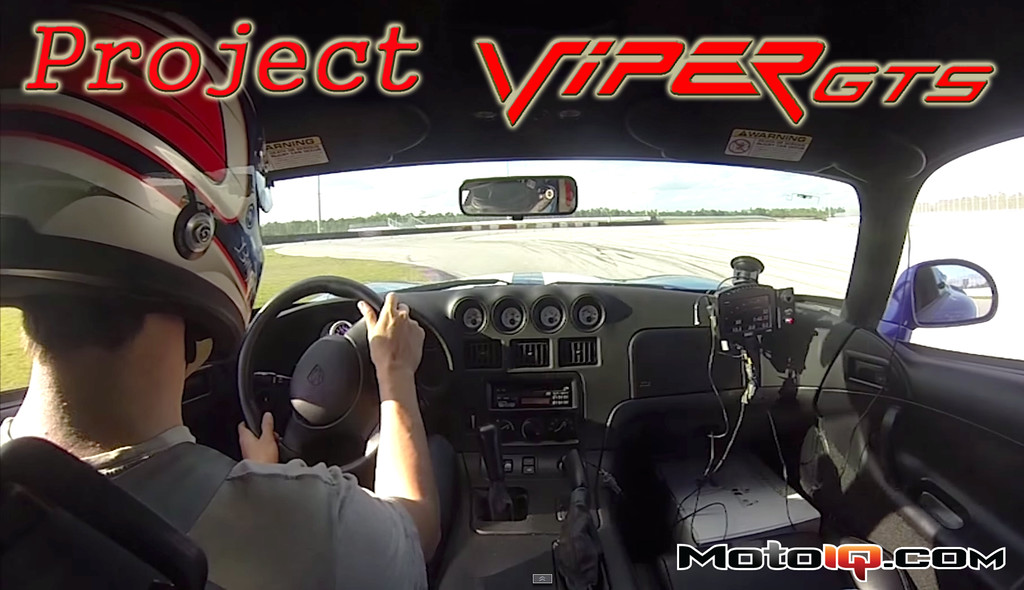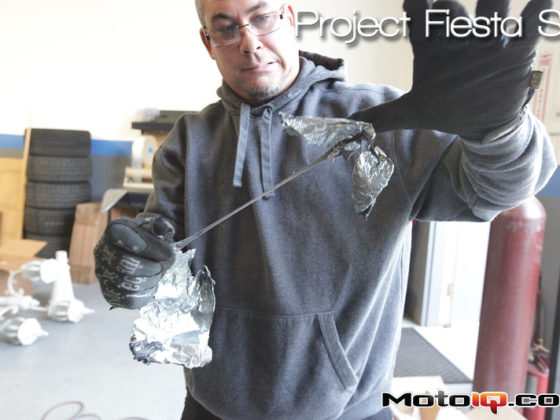The Viper has a reputation for being difficult to drive and even (incorrectly) known as a bad handling car. Since the 2nd Generation Viper has not been reviewed by a magazine in close to 15 years, we took Project Viper to the track to dispel some myths and assess the car’s balance and handling ability.
First off, what defines a “Driver’s Car”? What characteristics do “great handling” cars need to have? Is it pure cornering ability, the ability to put together a fast lap time, the intangible connection and communication between the car and its driver; and must it have a level of difficulty to challenge the driver and keep them on their toes? As I said in Part 1 of Project Viper:
“To me, a driver’s car is pure, engaging to drive, and responds to your inputs (for better or worse). The Viper easily fits this description and having a ridiculous amount of torque in a sleek body that nearly tops 200mph never hurts and adds to the fun factor.” – Billy Johnson
We were invited at the last minute to attend an open track day at Palm Beach International Raceway in Florida. While I race cars professionally and have a lot of seat time drifting 500hp Gen-3 SRT-10 Vipers during my years instructing at the Skip Barber Racing School, and despite having a lot of seat time tracking 600hp Gen-4s and ACR-Xs, I have never driven a Gen-2 Viper GTS on the track. Needless to say I was eager to asses a car that I’ve always been fond of in stock form before we start improving it.
With this short notice we did not have time to flush out the potentially 18 year old brake fluid. As it turned out it was the brake pads which gave up on us before the fluids boiled on track. Since our pads were glazing, we never had a chance to run a proper “hot lap”. You can see in the video (on Page 5) we took it easy on the straights and brake zones on the “pace lap”. We will have to wait until next time after we get our brakes sorted to do a proper hot lap.
HANDLING REVIEW
The Viper’s playful and neutral chassis makes it a lot of fun to drive. The car is not intimidating and with a little skill and maybe experience in a Miata or S2000, it is easy to feel comfortable and at home behind the wheel of one.
I’ve always enjoyed tracking Vipers and the Gen-2 was no different. Each generation Viper has its own nuances and quirks, and while the suspension dynamics get better with every year, for the most part the inherent character is the same across all generations. While our Gen 2 GTS’ behavior on the street is a bit rough around the edges like a modern-day hotrod (although the ride was not harsh like I expected it to be on the highway), on the track the chassis comes alive and feels more at home.
I was a bit surprised by the car’s body control and lack of pitch and roll while on track. I honestly expected it to move around a bit more, but the handling was predictable, the car cornered very flat, and it was quite a bit more tied down compared to the stock suspension of an NSX. I guess there’s a reason why it was consistently the fastest car on the track in magazine competitions.
The Viper’s chassis dynamics are very similar to that of a Miata or S2000. With proper technique and trailing off the brakes when entering a corner, the car dives down to the apex and can rotate into entry oversteer if desired; a characteristic that even the BMW M3 does not have. Carrying too much entry speed and overloading the front tires causes the Viper to understeer on entry, as it should. Mid-corner, the modern Michelin PS2 “C1” Viper-spec tires allowed the car to sustain over 1.0G with spikes up to 1.18Gs. At corner-exit, the Viper hooks up and puts power down very well with the massive Gen 3 / 4 sized 345/30-19 rear tires but if provoked with an aggressive throttle application, you can get power-on oversteer. Overall the handling was natural and predictable. The Viper can be balanced throughout a corner in a state of neutrality without fighting against an underlying balance of oversteer or understeer.
 The Viper has a relatively short 96.2” wheelbase (which grew to 98.8” in the Gen 3-5 cars). Combined with the extremely wide track width and quick steering, the Viper is very responsive and nimble which helped it turn record-breaking slalom times. In the late 90’s, the Viper was the fastest production car in the slalom for many magazines even though it was also one of the widest production cars ever made. But having this ability makes it a little twitchy when drifting.
The Viper has a relatively short 96.2” wheelbase (which grew to 98.8” in the Gen 3-5 cars). Combined with the extremely wide track width and quick steering, the Viper is very responsive and nimble which helped it turn record-breaking slalom times. In the late 90’s, the Viper was the fastest production car in the slalom for many magazines even though it was also one of the widest production cars ever made. But having this ability makes it a little twitchy when drifting.I’m sure it was obvious from the video that not all of my drifts were smooth. This was my first time tracking the car and the combination of the short wheelbase, wide track width, wide rear tires, and the original stock suspension damping, means you really have to be on top of it for smooth drifts. This probably explains why there are not many glory shots or videos of Gen 2 Vipers drifting. I might have to change that.
To put the Viper’s wheelbase into perspective, it’s only 1.7” longer than the Honda S2000’s 94.5” wheelbase while being substantially 6.8” wider (75.7” wide for the Viper and 68.9” for the S2000). This “square” footprint combined with 345-width rear tires makes drifting a bit trickier, but it’s a little easier to drift than the torque-less S2000. Both cars actually have very similar characteristics when driving them sideways.
Now the new 991 GT3 has a similar 96.7” wheelbase and is only 2.8” narrower than the Viper, but it runs on 40mm narrower rear tires. I believe these differences as well as the GT3’s 18 year newer technology, stiffer suspension, better damping, and fantastic chassis are key elements which make it easy to drift despite having a similar footprint. For comparison, a C7 Corvette has a 106.7” wheelbase and the BMW M4 drift-machine has a relatively massive 108.7” wheelbase that’s over a foot longer which makes sideways antics all but effortless.
While the Viper has a lot of roll stiffness (from big swaybars and I suspect relatively high roll centers) and the on-track damping was quite good for a stock car from the 90’s, there is a lot that can be improved in the car’s low-speed damping to refine the cornering dynamics to a modern standard. This will greatly reduce the ‘kick-back’ of the chassis when transitioning and should also make it easier to drift. We will find out once we track our Viper after going through the suspension.




